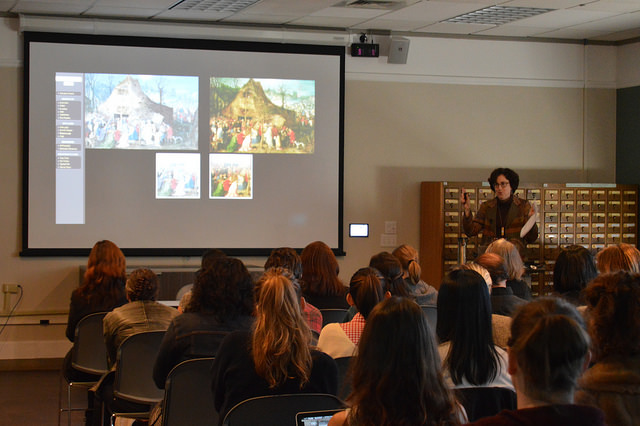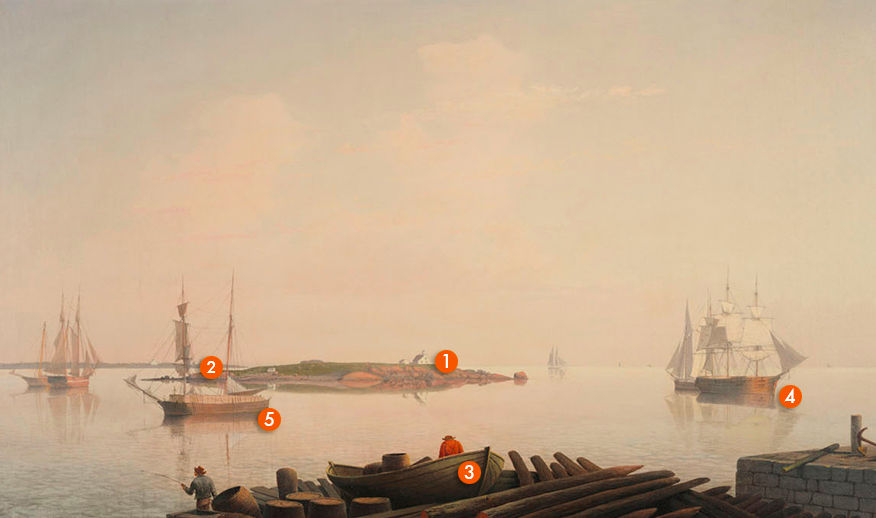What does the advent of big data have to offer art historians? What do art historians, well versed in the study of images, have to offer researchers in computational methods? What approaches are available to scholars studying large collections of images, and what types of research questions do these engender? How can we connect large image collections with rich metadata? Elizabeth Honig, DH Fellow and Associate Professor in History of Art, and Melissa Geisler Trafton, Senior Researcher, Fitz H. Lane Online, offered some avenues for further investigation at “Art History in the Age of Big Data” on November 13th.
 Honig began her talk with a question: what would it mean to treat art as data? Because art pieces often have both market value and research value, we are encouraged to focus on pieces as singular, precious, objects. To study them is to look at them closely, examine their details, and understand what makes the piece singular or unique. What would it mean, then, to approach art history from the lens of big data? How would practices of gathering and presenting data change? What new research questions would it raise?
Honig began her talk with a question: what would it mean to treat art as data? Because art pieces often have both market value and research value, we are encouraged to focus on pieces as singular, precious, objects. To study them is to look at them closely, examine their details, and understand what makes the piece singular or unique. What would it mean, then, to approach art history from the lens of big data? How would practices of gathering and presenting data change? What new research questions would it raise?
Honig’s research, which examines works produced by the 17th century Flemish painter, Jan Brueghel the Younger, and his family’s prolific workshop of apprentices, requires this wide view and large sets of data. Image elements, such as a cow, were reused in a variety of Brueghel paintings and may appear resized, flipped, cropped. Analyzing the technologies and techniques utilized for this mass production required amassing a large set of images to compare. After years of conducting her own research, Honig realized she had “a surplus of data” and wanted to make it available for others to perform analysis. Working with a team of undergraduate research apprentices, Honig set out to gather these works and their metadata in a free, openly editable database. The site includes several useful tools for investigation, such as transparencies and cropped magnifying glasses. Honig is currently working to develop an Open Catalogue Raisonné Platform so that art historians can easily aggregate and share their own catalogues. Once art historians have a database, new opportunities for cross-disciplinary collaboration emerge. Honig currently works with researchers in machine-learning and computer vision at Duke University who want to identify similar but varied elements across hundreds of images.
 Currently, Honig concluded, art historical data is relatively small. However, visual forms are complex data that could also be further enriched if they were interwoven with large metadata sets. Trafton is working to give the public easy and intuitive access to this type of contextualized knowledge through Fitz Henry Lane Online. Trafton noted that much of the narrative woven into Lane’s paintings is lost on modern viewers, who are unfamiliar with the world of shipping that dominates Lane’s various harborscapes. To that end, the Fitz Henry Lane Online is supported by many intersecting databases. In addition to information about the paintings as individual objects, entries are also connected to databases of painting owners, exhibitions, literature, and archival materials.
Currently, Honig concluded, art historical data is relatively small. However, visual forms are complex data that could also be further enriched if they were interwoven with large metadata sets. Trafton is working to give the public easy and intuitive access to this type of contextualized knowledge through Fitz Henry Lane Online. Trafton noted that much of the narrative woven into Lane’s paintings is lost on modern viewers, who are unfamiliar with the world of shipping that dominates Lane’s various harborscapes. To that end, the Fitz Henry Lane Online is supported by many intersecting databases. In addition to information about the paintings as individual objects, entries are also connected to databases of painting owners, exhibitions, literature, and archival materials.
During the question and answer period, an attendee raised a question about whether it would be possible to combine data from these two projects -- for instance, presenting Lane’s works alongside Brueghel’s as a step towards discussing common thematic elements, or using information from the Brueghel database as contextualizing material for the works of another artist, such as Lane. Honig and Trafton agreed that this would, in principle, be possible, though it would require the alignment of each site’s data with the structures provided by the other. As more art historians build upon the Open Catalogue Raisonné platform and develop their own systems for collecting and publishing data, it will become increasingly important to confront these questions of interoperability both in theory and in practice, in order to gather data at the scale necessary to facilitate new kinds of inquiry within the discipline of art history.
===
Images:
(1) Honig demosntrates the Image Investigation Tool on janbrueghel.net
(2) Interactive features on Fitz Henry Lane Online allow curators to tag elements and link to archival documents or explanatory prose.